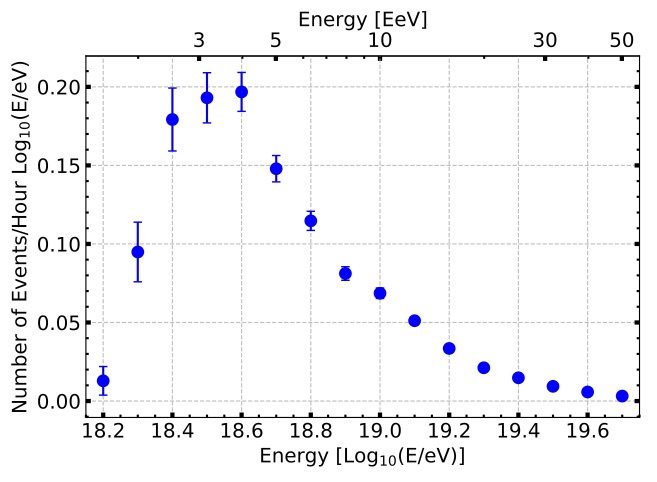
|
EUSO-SPB2
|

|
| Who is Who in the Collaboration | EUSO SPB1 | Cosmic Ray Physics | Neutrino Physics | New Physics Searches | Timeline Publications |
|
Cosmic rays are
defined as charged nuclei of non-solar origin, that is particles
accelerated in the Galaxy or, at higher energy, in extragalactic
astrophysical objects. At energies greater than 1 PeV, cosmic-ray
particles can be measured only indirectly by detecting the extensive
showers (EASs) of secondary particles they create in the Earth's
atmosphere
[arXiv:1807.09645].
Cosmic rays with energy exceeding 1 EeV, are referred to as ultrahigh-energy cosmic rays (UHECRs). EUSO-SPB2 will detect the fluorescent light from the Nitrogen
atoms in the atmosphere that are excited by the ionisation of the
shower charged particles produced by UHECRs. |

and the Cherenkov telescope (pointing at the Earth limb) on the right.
| The EUSO-SPB2 fluorescence telescope (FT) is a Schmidt design reflector with a 37.4 degrees times 11.4 degrees field of view. The FT records the longitudinal development of an EAS with a camera composed of multi-anode photo-multiplier tubes (MAPMTs) with a total of 6,912 pixels. The FT camera is designed to take images at microsecond timescales to detect the fluorescence emission of UHECR induced EAS with energies above a few EeV. The camera has a modular design following the layout of previous instruments such as EUSO-SPB1. While EUSO-SPB1 was equipped with only one Photo Detection Modules (PDM) consisting of 2,304 individual pixels, EUSO-SPB2 will fly 3 PDMs. The integration time was shortened from 2.5 microseconds in EUSO-SPB1 to 1 microsecond in EUSO-SPB2 to increase the signal to noise ratio. The optical system used in EUSO-SPB1 was a refractor with two Fresnel lenses. To increase the light collection onto the focal surface, the EUSO-SPB2 design was upgraded to a Schmidt system consisting of 6 mirror segments and a 1 meter diameter Schmidt corrector plate at the aperture providing the desired field of view. A detailed description of the FT is given in arXiv:2112.11130. |
| The UHECR sensitivity is shown in the figure below. Integrating over the entire energy span, we expect to record 0.12±0.01 events per observation hour which equates to roughly 0.6 events per night. Machine learning techniques will be used on board to identify these events and download them with the highest priority. This is necessary as a recovery of the whole data set is not guaranteed for a stratospheric balloon flight. |
